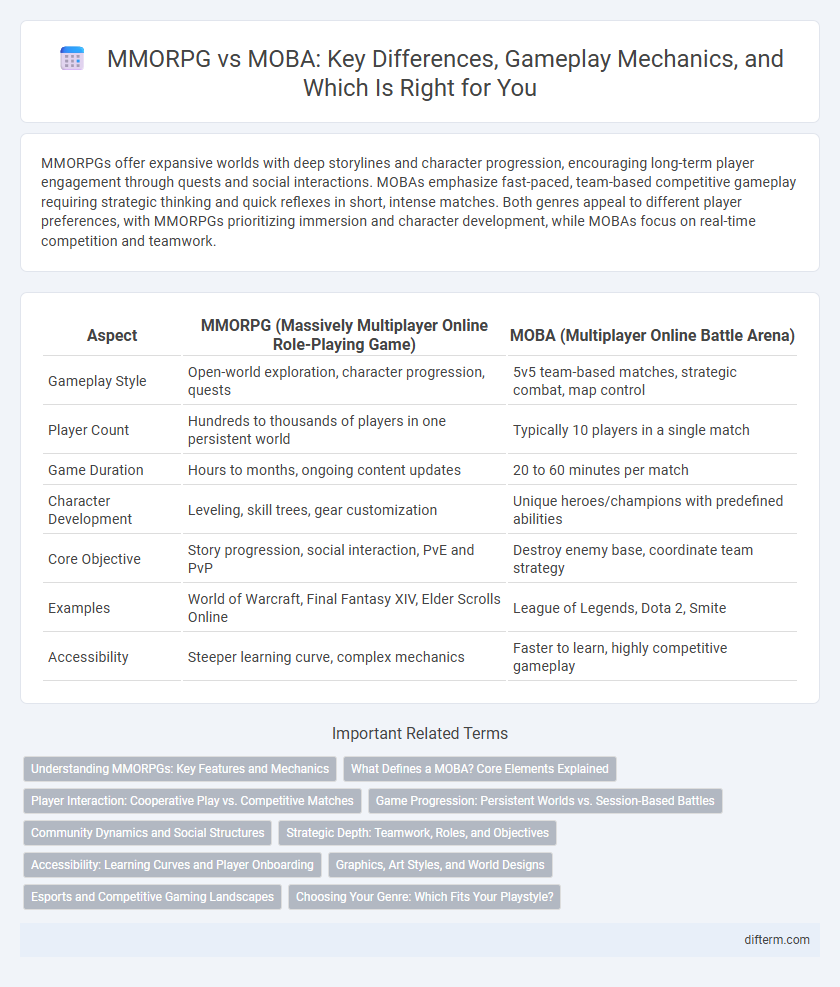MMORPGs offer expansive worlds with deep storylines and character progression, encouraging long-term player engagement through quests and social interactions. MOBAs emphasize fast-paced, team-based competitive gameplay requiring strategic thinking and quick reflexes in short, intense matches. Both genres appeal to different player preferences, with MMORPGs prioritizing immersion and character development, while MOBAs focus on real-time competition and teamwork.
Table of Comparison
| Aspect | MMORPG (Massively Multiplayer Online Role-Playing Game) | MOBA (Multiplayer Online Battle Arena) |
|---|---|---|
| Gameplay Style | Open-world exploration, character progression, quests | 5v5 team-based matches, strategic combat, map control |
| Player Count | Hundreds to thousands of players in one persistent world | Typically 10 players in a single match |
| Game Duration | Hours to months, ongoing content updates | 20 to 60 minutes per match |
| Character Development | Leveling, skill trees, gear customization | Unique heroes/champions with predefined abilities |
| Core Objective | Story progression, social interaction, PvE and PvP | Destroy enemy base, coordinate team strategy |
| Examples | World of Warcraft, Final Fantasy XIV, Elder Scrolls Online | League of Legends, Dota 2, Smite |
| Accessibility | Steeper learning curve, complex mechanics | Faster to learn, highly competitive gameplay |
Understanding MMORPGs: Key Features and Mechanics
MMORPGs (Massively Multiplayer Online Role-Playing Games) feature expansive, persistent worlds where thousands of players interact, complete quests, and develop characters through leveling and skill progression. Core mechanics include character customization, diverse quest lines, and social systems such as guilds and in-game economies that foster cooperation and competition. Unlike MOBAs, MMORPGs emphasize long-term progression and world exploration over fast-paced, team-based battles.
What Defines a MOBA? Core Elements Explained
A MOBA (Multiplayer Online Battle Arena) is defined by its strategic team-based gameplay, where players control a single hero or champion with unique abilities, battling to destroy the opposing team's base. Core elements include distinct lanes, jungle areas for neutral monster farming, and objectives like towers and inhibitors that influence map control and progression. Successful MOBA matches depend on teamwork, real-time decision-making, and precise execution of hero skills and tactics.
Player Interaction: Cooperative Play vs. Competitive Matches
MMORPGs emphasize cooperative play where players join forces in quests, raids, and guilds to achieve common goals, fostering deep social connections and teamwork. MOBAs prioritize competitive matches, pitting teams against each other in skill-based battles that require strategic coordination and quick decision-making. This fundamental difference shapes the player experience, with MMORPGs encouraging long-term collaboration and MOBAs focusing on dynamic, high-intensity competition.
Game Progression: Persistent Worlds vs. Session-Based Battles
MMORPGs offer persistent worlds where players experience continuous character growth, resource accumulation, and evolving storylines, fostering long-term engagement. MOBA games focus on session-based battles with character resets each match, emphasizing immediate skill execution and tactical adaptation. The progression in MMORPGs centers on lasting development, while MOBAs prioritize short-term performance and teamwork within isolated rounds.
Community Dynamics and Social Structures
MMORPGs foster expansive community dynamics through persistent worlds and guild systems, encouraging long-term social bonds and cooperative gameplay among thousands of players. MOBA games emphasize intense, short-term team coordination and competition, often creating tight-knit groups focused on strategy and real-time communication within smaller player rosters. The social structures in MMORPGs tend to be more diverse and hierarchical, while MOBAs promote agile, performance-driven alliances centered around ranked play and tournament participation.
Strategic Depth: Teamwork, Roles, and Objectives
MMORPGs emphasize long-term strategic depth through character progression, complex role specialization, and large-scale cooperative quests that require coordinated teamwork across diverse classes. MOBAs prioritize real-time strategic execution with defined hero roles, objective control like towers and buffs, and dynamic team coordination to adapt quickly during matches. Both genres demand strong communication and tactical planning but vary in scope, with MMORPGs focusing on expansive narratives and persistent worlds, while MOBAs drive intense, short-term competitive encounters.
Accessibility: Learning Curves and Player Onboarding
MMORPGs feature expansive worlds and complex mechanics, often requiring significant time for players to learn character progression, crafting systems, and quest dynamics, which can create a steeper onboarding curve. MOBAs provide more immediate gameplay with shorter matches and a focus on team-based strategy, allowing players to grasp core mechanics quickly but still demanding mastery of numerous heroes and map awareness. The accessibility of MOBAs typically appeals to casual players seeking quicker engagement, while MMORPGs attract dedicated gamers invested in long-term progression and exploration.
Graphics, Art Styles, and World Designs
MMORPGs typically feature expansive, intricately detailed world designs with diverse environments and realistic to stylized art styles, aiming for immersive exploration and long-term player engagement. MOBAs emphasize highly polished, character-focused graphics with vibrant, exaggerated art styles that prioritize clarity and visual impact during fast-paced, competitive matches. While MMORPG graphics support vast, persistent worlds for social interaction and questing, MOBA visuals are optimized for quick readability and dynamic action within confined arenas.
Esports and Competitive Gaming Landscapes
MMORPGs offer expansive worlds and character progression, fostering long-term player engagement, while MOBAs emphasize fast-paced, team-based strategy with clear objectives, making them highly spectator-friendly for esports. MOBAs like League of Legends and Dota 2 dominate competitive gaming with structured tournaments and high viewership, reflecting dynamic gameplay and frequent meta shifts. MMORPGs such as World of Warcraft maintain niche competitive scenes focused on PvP and raid speedrunning but lack the broad esports infrastructure seen in MOBAs.
Choosing Your Genre: Which Fits Your Playstyle?
MMORPGs immerse players in expansive virtual worlds with character progression, exploration, and social interaction, appealing to those who enjoy story-driven gameplay and long-term development. MOBAs emphasize real-time strategy and team-based competitive matches requiring quick reflexes, tactical thinking, and cooperation. Choosing between these genres depends on whether you prefer immersive role-playing experiences or fast-paced, strategic competition.
MMORPG vs MOBA Infographic

 difterm.com
difterm.com